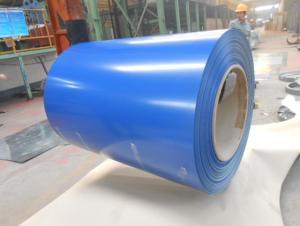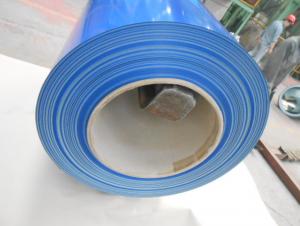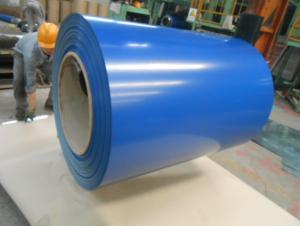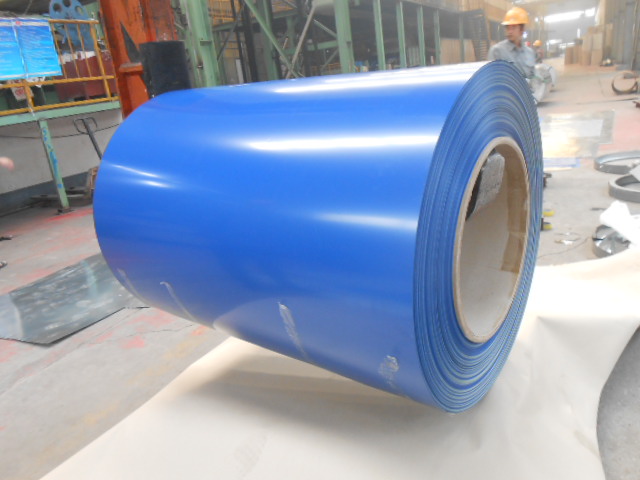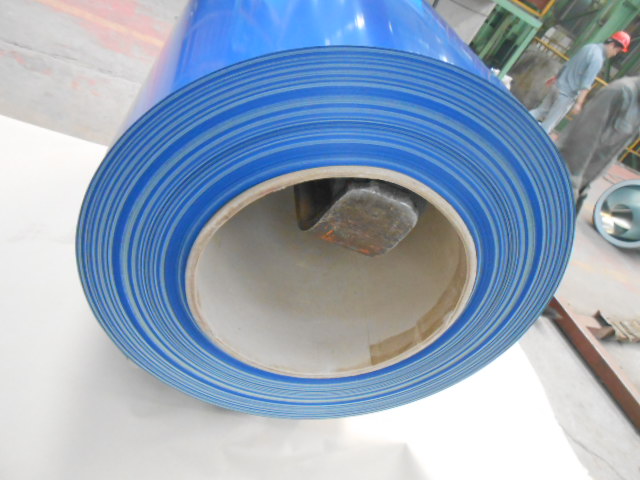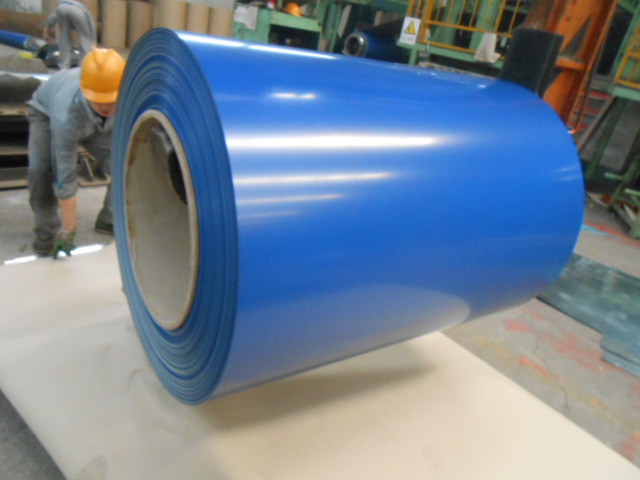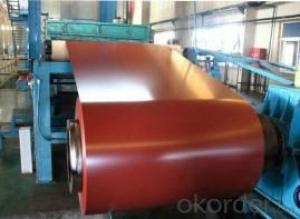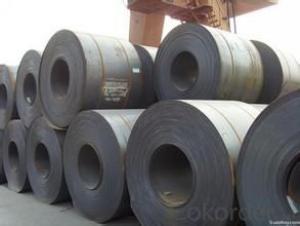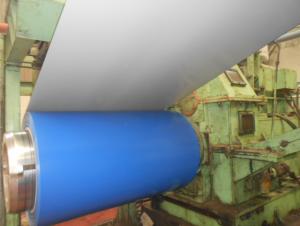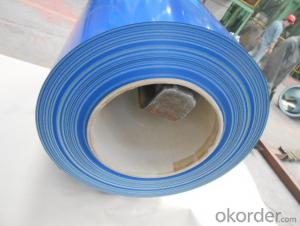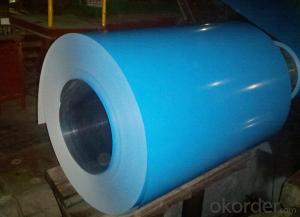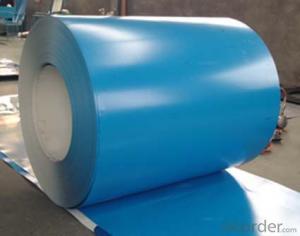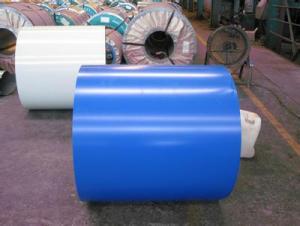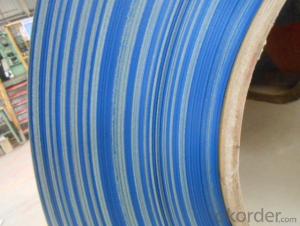Pre-Painted Galvanized/Aluzinc Steel Sheet in Coil Royal Blue 0.25mm
- Loading Port:
- Tianjin
- Payment Terms:
- TT OR LC
- Min Order Qty:
- 50 m.t.
- Supply Capability:
- 10000 m.t./month
OKorder Service Pledge
OKorder Financial Service
You Might Also Like
1. Pre-Painted Galvanized/Aluzinc Steel Coil Description:
With GI as base material, after pretreatment (degrease and chemical treatment ) and liquid dope with several layers of color, then after firing and cooling, finally the plate steel is called pre-painted galvanized (aluzinc) steel. Pre-painted galvanized steel is good capable of decoration, molding, corrosion resistance. It generally displays superior workability, durability and weather resistance.
2.Main Features of the Pre-Painted Galvanized/Aluzinc Steel Coil:
• Excellent process capability
• Smooth and flat surface
• Workability, durability
• Excellent heat resistance performance
• High strength
• Good formability
• Good visual effect
3.Pre-Painted Galvanized/Aluzinc Steel Coil Images
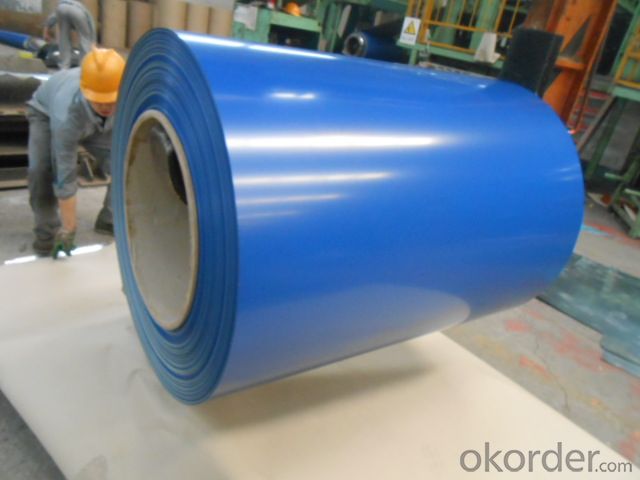
4.Pre-Painted Galvanized/Aluzinc Steel Coil Specification
Standard: AISI, ASTM, BS, DIN, GB, JIS
Grade: DX51D, DX52D
Thickness: 0.17-2.0mm
Brand Name: KMRLON
Model Number: coil
Type: Steel Coil
Technique: Cold Rolled
Surface Treatment: Coated
Application: Boiler Plate
Special Use: High-strength Steel Plate
Width: 20-1250mm
Length: customized
commoidty: pre-painted galvanized steel coil
Thickness: 0.13-4.0mm
width: 20-1250mm
zinc coating: 40-180g/m2
printing thickness: top side: 20+/-5 microns, back side: 5-7 microns
color: all RAL color
surface treatment: color coated
coil weight: 4-7 tons
coil ID: 508/610mm
packaging: standard seaworthy packing
5.FAQ of Pre-Painted Galvanized/Aluzinc Steel Coil
1. What’s the application of this product?
Roof, roof structure, surface sheet of balcony, frame of window, etc.
2. What’s the brand of the paint?
We use the best brand of all of the word—AKZO.
3. How about your company?
A world class manufacturer & supplier of castings forging in carbon steel and alloy steel,is one of the large-scale professional investment casting production bases in China,consisting of both casting foundry forging and machining factory. Annually more than 8000 tons Precision casting and forging parts are exported to markets in Europe,America and Japan. OEM casting and forging service available according to customer’s requirements.
4. How to guarantee the quality of the products?
We have established the international advanced quality management system,every link from raw material to final product we have strict quality test;We resolutely put an end to unqualified products flowing into the market. At the same time, we will provide necessary follow-up service assurance.
5. How long can we receive the product after purchase?
Usually within thirty working days after receiving buyer’s advance payment or LC. We will arrange the factory manufacturing as soon as possible. The cargo readiness usually takes 15-25 days, but the shipment will depend on the vessel situation.
- Q: How do steel coil manufacturers stay updated with industry trends?
- Steel coil manufacturers stay updated with industry trends by regularly attending industry conferences, trade shows, and seminars where they can network with other professionals and learn about the latest advancements and innovations in the steel coil industry. They also subscribe to industry publications, join professional associations, and participate in online forums and webinars to stay informed about market trends, new technologies, and industry best practices. Additionally, they actively engage with their customers and suppliers to gather feedback and insights, allowing them to adapt and stay ahead of the curve in this rapidly evolving industry.
- Q: I don't know why but I'm having a VERY difficult time finding the melting point of 1008 steel.
- It is still the same for 1008 steel. Go to the bottom and see the listing of the grades it covers. Since the only difference between the 1006 and 1008 steel is a few micro amounts of alloys and by far the greatest majority or main component is iron (99%), as a general melt temperature , 2750 F is the melt temperature at which the other alloys are added to the charge to fine tune the mix. Just like adding salt to distilled water actually lowers the boiling point of water, adding alloys to iron decreases the melting point of iron. The iron melts at 2800F, but once alloys to make the 1008 grade are added, it decreases melt temp to 2750F. Since the melting point of pure iron is 2800F, the temperature is actually decreased by adding these impurities of alloys. These alloys are tested while the mix is starting to come down from a pure melt, steel is sampled. and then alloys below are checked and added to make the 1008 steel. The steel is maintained at 2750 F so that the less volatile alloys don't boil off before combining with steel. Minimum Properties Ultimate Tensile Strength, psi 43,900 - 51,900 Yield Strength, psi 26,100 - 34,800 Elongation 42 - 48% Chemistry Iron (Fe) 99% Carbon (C) 0.08% Manganese (Mn) 0.6% max Phosphorus (P) 0.035% max Copper (Cu) 0.2% min Sulfur (S) 0.04%
- Q: Guitar?I have a steel- string, but prefer nylon.:)
- As people say, nylon strings are (generally) for classical/spanish acoustic guitars - put steel on those and goodbye guitar; the neck will bow and can break.. On other guitars then steel is what you need - if you put nylon on you will have no sustain and tonality. A reasonable guide is the string winding mechanism of the classical guitar. Actually, steel is a pretty much generic term as lots of steel strings are now coated or wound with bronze or phosphor-bronze etc. Strings also come in different gauges or thicknesses depending on what you play. Lighter strings are best for finger-picking and heavier for strumming. Electric guitar strings tend to be strung lighter than acoustic. Finally, a guitar is built for a certain string gauge. If you put strings on that are too light then you may get fret buzz but if you put strings on that are too heavy you could bow the neck of the guitar.
- Q: Im in the process of replacing the gutters/down spouts on my house. The top of the house is four sided. The bottom level has a porch area with 3 sides, two smaller roofs in the back, and one small roof on the side with all stainless steel gutters. A two story house. Not sure of the demensions. They were made at a Steel Mill where the previous owner, worked.This guy wants to buy the stainless gutters but I need to know the market value of this steel and offer him a price. Can someone tell me what I can sell it for? Does it go by the pound? Foot? Can you give me an idea please? Theres a lot of it! I have no clue what to do! Thanks!
- Steel is at an all time high of $3.99 per hundred pounds..Stainless will sell for more....I haulled a pickup truck full 3 days ago and got over a 100 bucks for junk I had laying around the yard.
- Q: How long do steel coils last?
- The durability of steel coils can differ based on different elements, including the steel's quality, the storage or usage conditions, and the specific application. Typically, top-notch steel coils can endure for numerous years or even decades before exhibiting any signs of deterioration or wear. Nevertheless, it is essential to acknowledge that if steel coils are not adequately maintained or shielded from moisture or harsh surroundings, they can be prone to corrosion. Consequently, consistent inspection, maintenance, and appropriate storage or usage methods play a pivotal role in optimizing the lifespan of steel coils.
- Q: What are the different methods of corrosion protection for steel coils?
- There are several different methods of corrosion protection for steel coils, each with its own advantages and disadvantages. 1. Coating: One of the most common methods is to apply a protective coating to the steel coils. This can be done through a variety of techniques such as hot-dip galvanizing, electroplating, or painting. Coatings provide a barrier between the steel surface and the corrosive environment, preventing direct contact and thus reducing the risk of corrosion. 2. VCI (Vapor Corrosion Inhibitor): Another method is the use of VCI materials, which release chemicals that inhibit corrosion when in contact with the steel surface. These materials can be applied as coatings, films, or papers, and are particularly useful for long-term storage or shipping of steel coils. 3. Cathodic Protection: This method involves the use of sacrificial anodes or impressed currents to protect the steel coils. Sacrificial anodes, typically made of zinc or aluminum, are connected to the steel surface. These anodes corrode instead of the steel, sacrificing themselves to protect the coils. Impressed current systems use a direct electrical current to prevent corrosion on the steel surface. 4. Wrapping and Packaging: Proper wrapping and packaging of steel coils can also provide corrosion protection. This includes using moisture barrier films, desiccants, or absorbent materials to reduce the moisture content around the coils. Additionally, ensuring adequate ventilation and avoiding contact with other corrosive substances can help prevent corrosion. 5. Environmental Control: Controlling the environment in which the steel coils are stored or used is crucial for corrosion protection. This may involve maintaining proper humidity levels, controlling temperature, and managing air quality. By minimizing exposure to corrosive elements such as moisture, salts, or chemicals, the risk of corrosion can be significantly reduced. It is important to note that the choice of corrosion protection method depends on various factors such as the specific application, budget constraints, and desired lifespan of the steel coils. A combination of these methods may also be used to provide enhanced protection against corrosion.
- Q: What are the dimensions of steel coils used in the electrical equipment industry?
- The dimensions of steel coils used in the electrical equipment industry can vary depending on the specific application and requirements of the equipment being manufactured. However, there are some common dimensions that are frequently used in this industry. Typically, the width of steel coils used in electrical equipment manufacturing ranges from 0.5 inches to 72 inches (1.27 cm to 182.88 cm). The thickness of these coils can vary from as thin as 0.005 inches (0.0127 cm) to as thick as 0.25 inches (0.635 cm). The length of steel coils used in the electrical equipment industry can also vary, but it is often determined by the manufacturing process and the specific equipment being produced. Coils can range from a few feet to several hundred feet in length. Furthermore, the weight of steel coils can vary depending on their dimensions and the type of steel being used. For instance, a common weight range for steel coils used in the electrical equipment industry is between 5,000 pounds (2,268 kg) and 50,000 pounds (22,680 kg). It is important to note that these dimensions are not fixed and can vary based on the specific needs of the electrical equipment industry. Manufacturers may have their own unique specifications and requirements for the steel coils they use in their products.
- Q: What are the advantages of using steel coils in the manufacturing industry?
- Using steel coils in the manufacturing industry offers several advantages. Firstly, steel coils are renowned for their strength and durability, making them an ideal choice for various manufacturing processes. They can withstand heavy loads and resist deformation, ensuring that the final product is reliable and long-lasting. Secondly, steel coils are highly versatile and can be used in a wide range of applications across different industries. They can be shaped, molded, or cut into different forms and sizes, catering to diverse manufacturing needs. Additionally, steel coils are cost-effective. Their strength and durability result in a longer lifespan compared to other materials, reducing the need for frequent replacements and leading to cost savings in the long run. Furthermore, steel coils have excellent thermal conductivity, meaning they can efficiently transfer heat. This makes them suitable for applications that require temperature regulation, such as in the automotive and HVAC industries. Moreover, using steel coils in the manufacturing process contributes to a more sustainable and eco-friendly approach. Steel is one of the most recycled materials globally, reducing the need for raw materials extraction and energy consumption, and resulting in a reduced carbon footprint. Furthermore, steel coils can be coated with protective layers to enhance their resistance to rust and corrosion. This makes them suitable for outdoor applications or industries with corrosive environments. Lastly, steel coils offer consistent quality and uniformity in terms of dimensions, mechanical properties, and surface finish. This ensures that the end products meet the required specifications and maintain a high level of quality. To summarize, the advantages of using steel coils in the manufacturing industry include their strength, durability, versatility, cost-effectiveness, excellent thermal conductivity, recyclability, corrosion resistance, and consistent quality. These benefits make steel coils a popular choice for various manufacturing processes across different industries.
- Q: can steel boil and turn into a gaseous state?? if so how hot does it have to be for it to boil
- The amount of heat needed can be generated. The heat on the surface of the sun is sufficient. Steel will break down before it gets that hot. The carbon in the steel will oxidize into carbon dioxide, or vaporize into carbon gas. The outer core of the Earth is composed of molten iron and nickel. Its also done in steel plants every day.
- Q: Specifically, for the main support beam found in a basement.
- Steel is better. You can use a smaller size compared to wood, it will handle more weight and will not deflect like a lam beam can and will. I've worked in a lot of older houses and the ones with steel beams always had far less differential settling than those with wood beams.
Send your message to us
Pre-Painted Galvanized/Aluzinc Steel Sheet in Coil Royal Blue 0.25mm
- Loading Port:
- Tianjin
- Payment Terms:
- TT OR LC
- Min Order Qty:
- 50 m.t.
- Supply Capability:
- 10000 m.t./month
OKorder Service Pledge
OKorder Financial Service
Similar products
Hot products
Hot Searches
Related keywords
